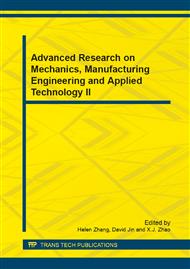[1]
A.M. Thompson, T. Hu, and C.L. Eshelbrenner: Antihypertensive treatment and secondary prevention of cardiovascular disease events among persons without hypertension: a meta-analysis. JAMA. 305(9). 913-922 (2011).
DOI: 10.1001/jama.2011.250
Google Scholar
[2]
Jing Song, H.L. Yan: Effect of high-temperature operation on cardiovascular system. Chin Occup Med. 33(2). 149-150 (2006).
Google Scholar
[3]
Nielsen, Bodil, in: Heat and Cold in Encyclopedia of Occupational Health and Safety, edtied by M.S. Jeanne, International Labor Organization, Geneva (2011).
Google Scholar
[4]
A.V. Chobanian, G. L. Bakris and H.R. Black: The Seventh Report of the Joint National Committee on Prevention, Detection, Evaluation, and Treatment of High Blood Pressure: the JNC 7 report. JAMA. 289(19). 2560-2572 (2003).
DOI: 10.1001/jama.289.19.2560
Google Scholar
[5]
R.F. Li, J.Y. Sun, and P Zhang: Influencing factors of hypertension in steel workers exposed to heat stress. Chinese Journal of Public Health. 25(7). 818-820 (2009).
Google Scholar
[6]
M.N. Sawka, L.M. Burke and E.R. Eichner: American College of Sports Medicine position stand. Exercise and fluid replacement. Med Sci Sports Exerc. 39(2). 377-390 (2007).
Google Scholar
[7]
T.D. Chinevere, R.W. Kenefick and S.N. Cheuvront: Effect of heat acclimation on sweat minerals. Med Sci Sports Exerc. 40(5). 886-891 (2008).
DOI: 10.1249/mss.0b013e3181641c04
Google Scholar
[8]
Q. Yang, Z. Zhang, and E.V. Kuklina: Sodium intake and blood pressure among US children and adolescents. Pediatrics. 130(4). 611-619 (2012).
DOI: 10.1542/peds.2011-3870
Google Scholar
[9]
M.L. Chateau-Degat, A. Ferland and S. Dery: Dietary sodium intake deleteriously affects blood pressure in a normotensive population. Eur J Clin Nutr. 66(4). 533-535 (2012).
DOI: 10.1038/ejcn.2012.8
Google Scholar
[10]
C.G. Crandall and J. Gonzalez-Alonso: Cardiovascular function in the heat-stressed human. Acta Physiol (Oxf). 199(4). 407-423 (2010).
DOI: 10.1111/j.1748-1716.2010.02119.x
Google Scholar
[11]
C.S. Johnson: Arterial blood pressure and hyperviscosity in sickle cell disease. Hematol Oncol Clin North Am. 19(5). 827-837, vi (2005).
DOI: 10.1016/j.hoc.2005.08.006
Google Scholar
[12]
Y. Lamarre, M.L. Lalanne-Mistrih and M. Lemonne: Male gender, increased blood viscosity, body mass index and triglyceride levels are independently associated with systemic relative hypertension in sickle cell anemia. PLoS One. 8(6). E66004 (2013).
DOI: 10.1371/journal.pone.0066004
Google Scholar


